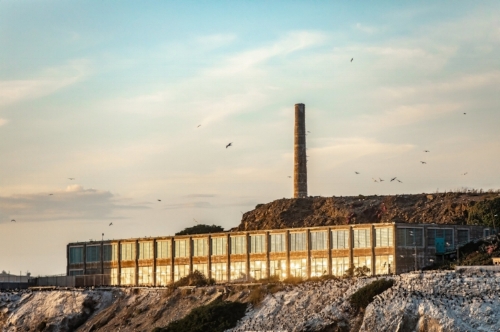Farallon Institute Newsletter - Fall 2018
Warmer than average sea surface temperatures in the Gulf of Alaska and off Baja California may impact California’s winter ocean and weather conditions (see below).
Around The Office
The “State of the Ocean” presentation series continued rolling in October with a lively Saturday evening at the Inverness Yacht Club. Fifty people came to hear about the challenges facing healthy marine ecosystems and to learn about what the future of our oceans might look like under a changing climate. The next scheduled talk is November 8th at 7:30 p.m. at the Richardson Bay Audubon Center, in Tiburon, CA. The event is open to the public so please come on out and share the event with friends who might be interested.
Farallon Institute has appointed two University of California, Davis graduate students as California Sea Grant Trainee Fellows to work on our project estimating krill biomass using acoustic data. Helen Killeen is pursuing a Ph.D. studying the impacts of the physical ocean on fish larvae and Conner Dibble is finishing up his Ph.D. working on understanding how the transport of invertebrate larvae structures marine populations. We are excited to welcome them to Farallon Institute.
State of the Ocean - Fall 2018
The fall ocean conditions off California are fairly normal, as they consistently have been since the beginning of 2018. We track these conditions with the Multivariate Ocean Climate Indicator (MOCI), which is updated seasonally. The forecast for the upcoming winter, on the other hand, is more uncertain, as a weak El Niño might be forming in the tropical Pacific (although neutral conditions existed up to September 2018). While the chances of El Niño occurring are up to 75% (https://www.climate.gov/enso), the effects of a weak El Niño event on California are not consistent and aren’t usually strong. Coincidentally, a more persistent warming in the Gulf of Alaska and farther south in Baja California might have a larger role to play in California ocean conditions this fall and winter (see sea surface temperature anomalies map above). NOAA is indeed predicting a milder winter for us! Check out https://www.climate.gov/news-features/blogs/enso/another-mild-winter-noaa%E2%80%99s-2018-19-winter-outlook for some cool visualizations of how every El Niño since 1950 has impacted U.S. temperature and rainfall patterns. While we tend to think El Niños always bring warm temperatures and rain to California, that isn’t always the case!
Photo courtesy of California Department of Fish and Wildlife
Dungeness crab fishery update
The 2018 recreational Dungeness crab fishery is delayed north of Patrick’s Point, California, due to high levels of domoic acid in crab tissues. The commercial fishery is set to open in mid November, but will be dependent on domoic acid levels that are measured in the next couple weeks. Domoic acid is neurotoxin produced by naturally-occurring marine phytoplankton. The phytoplankton are eaten by filter-feeding organisms (shellfish, sardines, anchovy) and the toxin accumulates in their tissues. The toxin does not impact these organisms but they pass it along to the predators that eat them. Seabirds, marine mammals, and humans are all impacted by eating organisms that have high levels of domoic acid. For that reason, the California Department of Fish and Wildlife has monitoring programs in place to test marine organisms for the toxin and close the fishery if needed. You can find more information on domoic acid here and the latest information on fisheries that are impacted by domoic acid here.
Photo courtesy of The Pew Charitable Trusts
Antarctic marine protected areas
In collaboration with the Antarctic Ecosystem Research Division of the Southwest Fisheries Science Center, Dr. Emily Klein has been using an ecosystem model to explore how a proposed marine protected area (MPA) might impact the ecosystem and international krill fisheries around the Antarctic Peninsula and in the Scotia Sea. Outcomes of this work have demonstrated how an MPA may alleviate risks associated with overlaps between krill fishing and foraging by krill-dependent predators, such as penguins and seals, but might also incur costs to the fishery when vessels are displaced from areas closed to fishing. This research helped Chile and Argentina refine their MPA plan, and directly influenced the final proposal officially submitted for consideration by international management in the Antarctic. That proposal is currently under consideration at the annual meeting of the Commission for the Conservation of Antarctic Marine Living Resources, the body that regulates the use of living resources in the Antarctic.
Alcatraz Island seabird research, 2018
September marked the end of the 25th consecutive year in which research on nesting seabirds of Alcatraz Island has been conducted. There are nine bird species that call Alcatraz home between March and September and scientists at Farallon Institute track the population size, breeding success, and disturbance of the two most numerous species: western gulls and Brandt’s cormorants. In 2018, the cormorants reached their highest numbers ever observed on Alcatraz, with over 2,000 nesting pairs! Preliminary reproductive results suggest that cormorants also had an above average year in which a lot of chicks were successfully raised. These two factors combined indicate a very healthy 2018 population. We also observed an increase in the number of nesting western gull pairs, which, like the cormorants, had a successful breeding season that was well above average.




